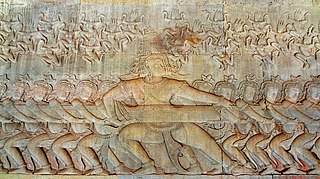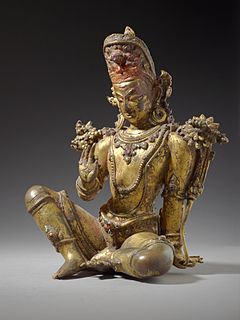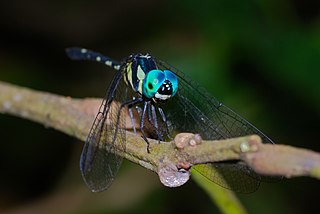
Asuras are a class of beings in Indian religions. They are described as power-seeking clans related to the more benevolent Devas in Hinduism. In its Buddhist context, the word is sometimes translated "titan, "demigod", or "antigod".
Hindu deities are the gods and goddesses in Hinduism. The terms and epithets for deity within the diverse traditions of Hinduism vary, and include Deva, Devi, Ishvara, Ishvari, Bhagavān and Bhagavati.

Boiga is a type of cat snake, in the large genus of opisthoglyphous (rear-fanged), mildly venomous snakes, known commonly as cat-eyed snakes or simply cat snakes, in the family Colubridae. Species of the genus Boiga are endemic to southeast Asia, India, and Australia, but due to their extremely hardy nature and adaptability, have spread to many other suitable habitats around the world. There are 34 recognized species in the genus. According to the study done by Jiri Smid regarding Old World cat snakes, the ancestor of the cat snake originated in Africa, from where it diversified and expanded to other countries. Despite this diversity however, the different species have very similar needs in terms of temperature and precipitation.

Deva means "heavenly, divine, anything of excellence", and is also one of the terms for a deity in Hinduism. Deva is a masculine term; the feminine equivalent is Devi.

A daeva is a Zoroastrian supernatural entity with disagreeable characteristics. In the Gathas, the oldest texts of the Zoroastrian canon, the daevas are "gods that are rejected". This meaning is – subject to interpretation – perhaps also evident in the Old Persian "daiva inscription" of the 5th century BCE. In the Younger Avesta, the daevas are divinities that promote chaos and disorder. In later tradition and folklore, the dēws are personifications of every imaginable evil.

The Samudra Manthana is one of the best-known episodes in the Hindu philosophy narrated in the Bhagavata Purana, in the Mahabharata and in the Vishnu Purana. The Samudra Manthana explains the origin of Amrita.

An asura in Buddhism is a demigod or titan of the Kāmadhātu. They are described as having three heads with three faces each and either four or six arms.
The Kālakeyas or Kālakhañjas are a class of Asura in Buddhist and Hindu mythology. They were a powerful, ferocious and cruel clan of the Dānavas.
Amomyrtella irregularis is a species of tree in the myrtle family, Myrtaceae. It is endemic to Ecuador, where it grows in the humid forests of the southern Andes. Its common name is mate-mate.

Asura is a genus of moths in the subfamily Arctiinae erected by Francis Walker in 1854.

Asura's Wrath is an action video game developed by CyberConnect2 and published by Capcom. Asura's Wrath was first announced at the Tokyo Game Show in 2010, and was released worldwide in February 2012. The game is playable on PlayStation 3, Xbox 360, Xbox One & Xbox Series X/S via 360 backwards compatibility, and the PlayStation 4 and PC via PlayStation Now.
Asura strigipennis is a moth of the family Erebidae. It was described by Gottlieb August Wilhelm Herrich-Schäffer in 1914. It is found on Java, Sumatra and in China, Taiwan and India.
Asura avernalis is a moth of the family Erebidae. It is found on the Solomon Islands and Bougainville Island.
Asura quadrilineata is a moth of the family Erebidae. It is found on Aru and in Australia.

Cyme sexualis is a moth of the subfamily Arctiinae first described by Felder in 1864. It is found on Ambon, Sulawesi, the Dampier Archipelago. and in New Guinea.
Cyme basitesselata is a moth of the subfamily Arctiinae.

Rhizophagus irregularis is an arbuscular mycorrhizal fungus used as a soil inoculant in agriculture and horticulture. In addition, it is one of the best mycorrhizal varieties of fungi available to mycoforestry, but as it does not produce fruiting bodies it "has virtually no market value as an edible or medicinal mushroom"

Acropora abrotanoides is a species of acroporid coral found in Indo-Pacific waters from the Red Sea and the Gulf of Aden east to the East China Sea, Japan, the central Pacific Ocean and Australia. It is found in shallow coral reefs that are exposed to the action of strong waves, at depths up to 15 m. It is vulnerable to coral bleaching, disease and crown-of-thorns starfish. It is resistant to predation as it has well-developed radial corallite lips.

Tetrathemis irregularis is a species of dragonfly in the family Libellulidae, known as the rainforest elf. It is a tiny to small, slender dragonfly with black and yellow markings. It inhabits rainforest streams in north-eastern Australia and Southeast Asia, including the Aru Islands.










